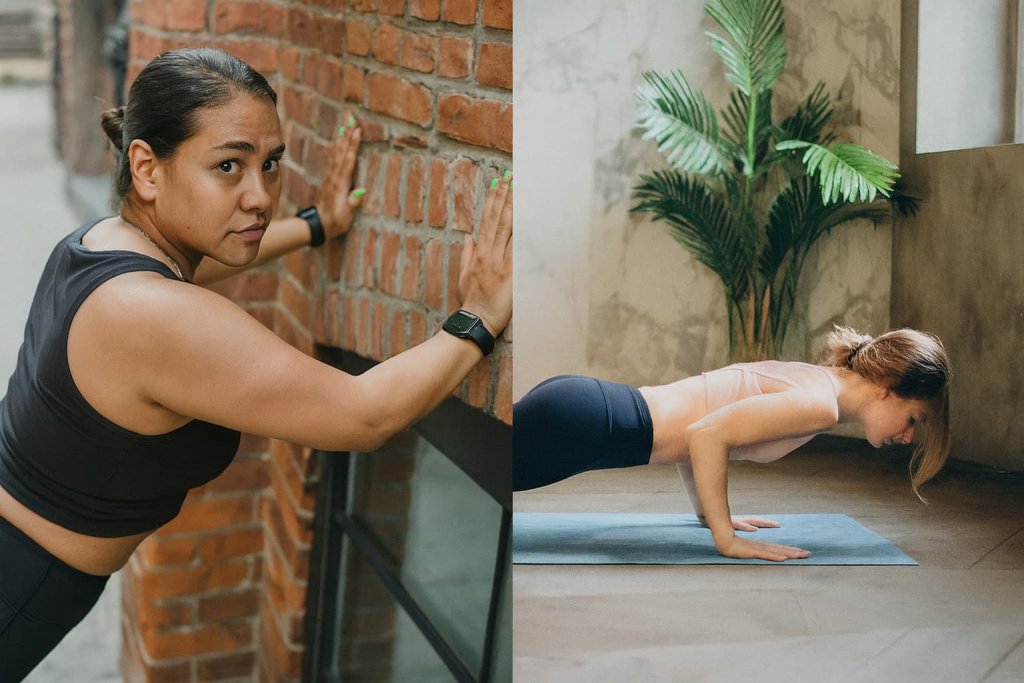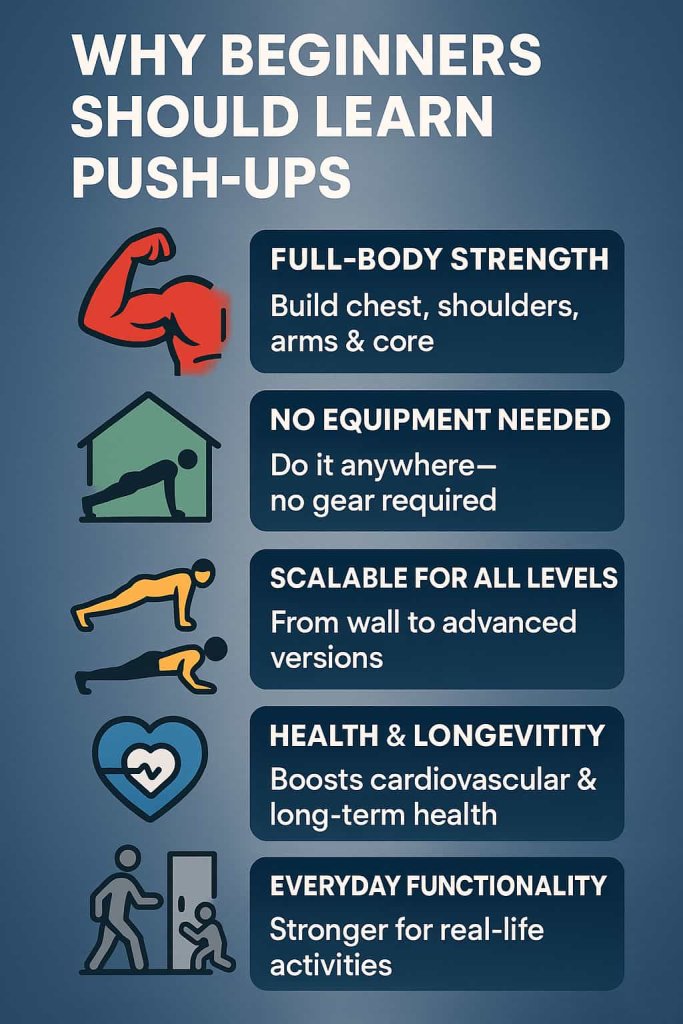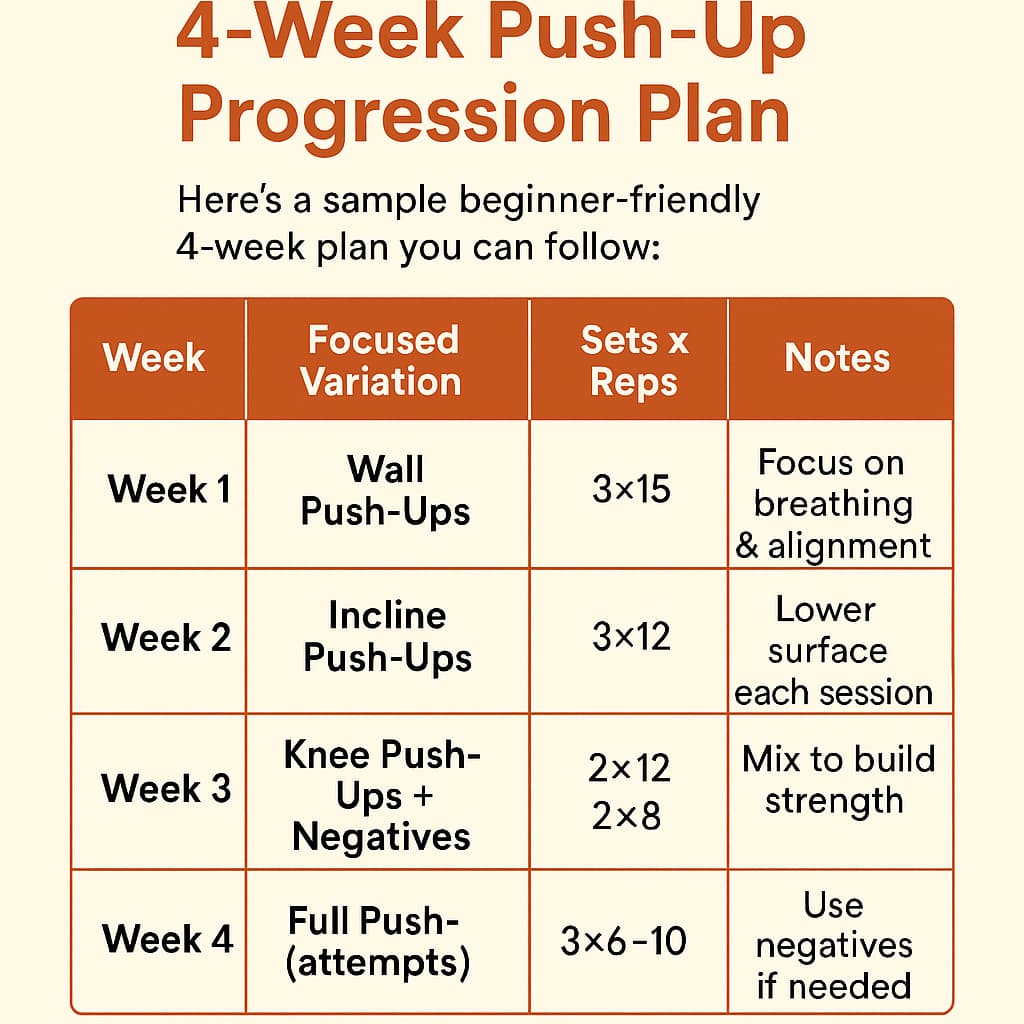Yes—you can go from wall push-ups to full floor push-ups in just a few weeks. The key is starting with the right progression and focusing on proper form. Push-ups are one of the most effective bodyweight exercises for building strength in your chest, arms, shoulders, and core—all without needing a gym.

For beginners, mastering push-ups step by step ensures safety, builds confidence, and prevents wrist or shoulder injuries. In this guide, you’ll learn why push-ups matter, the exact progression plan, common mistakes, trainer tips, and a 4-week sample program to help you succeed.
Why Beginners Should Learn Push-Ups
Push-ups are a foundational movement that almost every fitness program includes. Here’s why they matter:

- Full-Body Strength → Push-ups target your chest (pectorals), shoulders (deltoids), arms (triceps), and stabilize your abs, glutes, and legs.
- No Equipment Needed → You can do them anywhere—at home, in the office, or on vacation.
- Scalable for All Levels → Wall push-ups make it beginner-friendly, while advanced versions (diamond, decline, plyometric) challenge even athletes.
- Health & Longevity → A 2025 Guardian report highlighted push-ups as one of the best exercises to support healthy aging and cardiovascular fitness.
- Everyday Functionality → Training push-ups improves your ability to push heavy doors, get up from the ground, or play with kids.
👉 According to the American Council on Exercise (ACE), mastering bodyweight movements like push-ups improves functional strength and reduces injury risk compared to jumping straight into heavy weightlifting (ACE Fitness).
Beginner Push-Up Progression (Step by Step)
The smartest way to build push-up strength is with a structured progression. Instead of forcing a floor push-up before you’re ready, you’ll gradually reduce assistance until your body can handle its full weight.
1. Wall Push-Ups (Level 1)
- How to do it: Stand facing a wall, arms extended at shoulder height. Place palms flat, slightly wider than shoulders. Bend elbows and bring your chest toward the wall, then push back.
- Muscles worked: Chest, arms, shoulders.
- Why it works: Reduces bodyweight load, letting you focus on posture and breathing.
- Trainer Tip: Squeeze your glutes and keep abs tight to avoid arching.
- Progression goal: 3 sets of 15 smooth reps.
2. Incline Push-Ups (Level 2)
- How to do it: Place hands on a sturdy surface like a table, bench, or couch. Lower chest toward the surface, then push back up.
- Muscles worked: Chest and triceps under slightly higher load than wall push-ups.
- Why it works: The lower the surface, the harder the push-up. Perfect for step-by-step progression.
- Trainer Tip: Don’t let your hips sag—pretend you’re in a straight plank.
- Progression goal: Lower the incline every 1–2 weeks until you reach knee push-ups.
3. Knee Push-Ups (Level 3)
- How to do it: From plank position, drop your knees to the ground. Keep body straight from shoulders to knees. Lower your chest toward the floor, then push back.
- Muscles worked: Chest, triceps, shoulders.
- Why it works: Removes some bodyweight but keeps movement close to the real push-up.
- Trainer Tip: Avoid “hinging” at the hips—your body should move as one unit.
- Progression goal: 3 sets of 12–15 clean reps.
4. Negative (Eccentric) Push-Ups (Level 4)
- How to do it: Start in a full push-up position. Slowly lower yourself to the floor in 4–5 seconds. Drop to knees to reset.
- Why it works: Builds strength in the hardest phase of the movement.
- Trainer Tip: Focus on slow, controlled lowering—don’t let your chest “drop.”
- Progression goal: 3 sets of 8–10 reps.
5. Full Push-Ups (Level 5 – Goal)
- How to do it: Start in a high plank, hands under shoulders, body in a straight line. Lower until chest nearly touches the floor, then push back up.
- Muscles worked: Chest, triceps, shoulders, core, glutes.
- Trainer Tip: Keep elbows at ~45° to avoid shoulder strain.
- Progression goal: 3 sets of 8–12 reps.
4-Week Push-Up Progression Plan

Here’s a sample beginner-friendly 4-week plan you can follow:
| Week | Focused Variation | Sets x Reps | Notes |
|---|---|---|---|
| 1 | Wall Push-Ups | 3×15 | Focus on breathing & alignment |
| 2 | Incline Push-Ups | 3×12 | Lower surface each session |
| 3 | Knee Push-Ups + Negatives | 2×12 + 2×8 | Mix to build strength |
| 4 | Full Push-Ups (attempts) | 3×6–10 | Use negatives if needed |
👉 Training push-ups 3 non-consecutive days per week ensures steady progress while avoiding overtraining.
Common Push-Up Mistakes Beginners Make
- ❌ Elbows flared too wide – stresses shoulders.
- ❌ Sagging hips – weak core engagement.
- ❌ Neck craning down – causes tension and poor form.
- ❌ Rushing through reps – reduces strength gains.
👉 Filming your form once per week helps you spot mistakes early.
Benefits of Mastering Push-Ups

- Builds a strong, defined chest and arms.
- Enhances core stability and posture.
- Improves athletic performance in sports like tennis, golf, and running.
- Boosts calorie burn and supports fat loss.
- Increases functional strength for daily activities.
👉 Push-up progressions improve stability and motor control—skills that translate to better overall fitness.
Expert Trainer Tips for Faster Results
- Start each session with a 30-second plank to prime core engagement.
- Use push-up bars or dumbbells if wrists hurt.
- Add eccentric (slow) reps to break plateaus.
- Track reps in a notebook to see weekly progress.
- Don’t chase numbers—quality reps matter more than quantity.
FAQs About Beginner Push-Ups
1. How long will it take to do full push-ups?
Most beginners can achieve their first floor push-up in 4–8 weeks with consistent practice.
2. Are knee push-ups effective?
Yes—knee push-ups are an important step to build pressing strength before progressing to full push-ups.
3. Should I do push-ups every day?
No. Train push-ups 3 days per week with at least one rest day in between.
4. Can push-ups replace weight training?
Not fully. Push-ups are great for beginners, but adding weights later (like bench press) boosts strength further.
5. My wrists hurt—what should I do?
Use push-up handles, do wrist stretches, or try wall/incline push-ups until wrists strengthen.
6. Do push-ups burn belly fat?
Not directly. Fat loss requires a calorie deficit. Push-ups help by building lean muscle and boosting metabolism.
7. Should women train push-ups differently?
No. The same progression works for men and women. Strength adapts the same way.
Conclusion
Going from wall to floor push-ups is 100% possible—even if you can’t do one right now. By following a structured progression (wall → incline → knee → negatives → floor), practicing 3 times a week, and focusing on perfect form, you’ll build the strength and confidence to perform push-ups like a pro.
👉 Start today with wall push-ups. In just a month, you could be performing your first full push-up on the floor—a huge milestone in your fitness journey!
